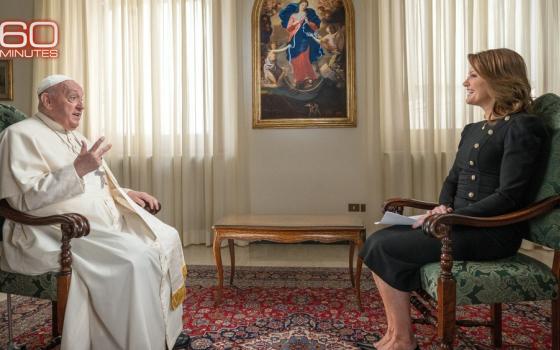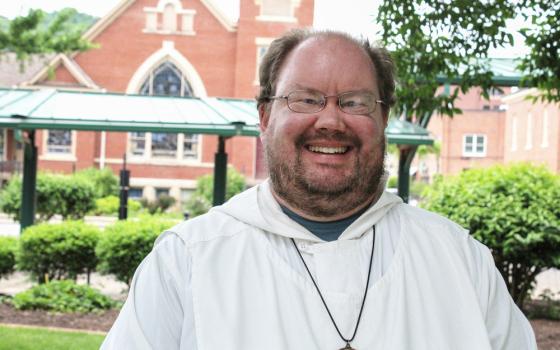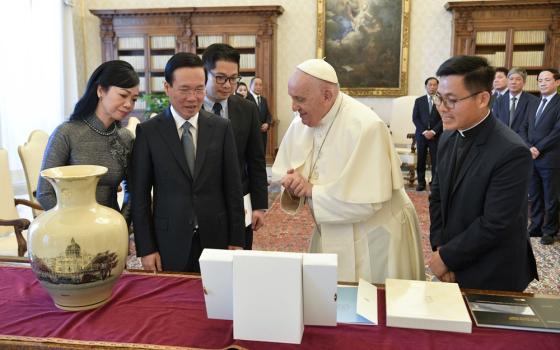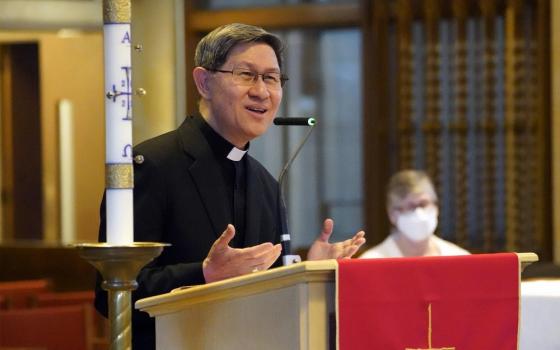
WASHINGTON -- Just two years after it was published, the U.S. bishops’ doctrinal framework for high school catechetics has begun wending its way toward implementation in school and parish programs.
Progress is uneven, however.
According to a former catechetical official for the U.S. bishops, “A number of dioceses have taken the [framework’s doctrinal] elements and made them their policy. Others have started the process. Others are just ignoring them.”
In November 2007 the U.S. bishops adopted a doctrinal framework for adolescent catechesis, ponderously titled “Doctrinal Elements of a Curriculum Framework for the Development of Catechetical Materials for Young People of High School Age.” The framework spells out what central elements of Catholic teaching and practice ought to be included within each of six core and five possible elective courses over eight semesters of high school religious education. (See sidebar below.)
“We’ve probably grabbed hold of it quicker and moved further and faster on it than most dioceses,” said Annette Lentz, executive director of the Indianapolis archdiocesan Secretariat for Catholic Education and Faith Formation.
It probably helped, she added, that Indianapolis Archbishop Daniel M. Buechlein has long been deeply involved in catechetics on the national level and was on the bishops’ committee that developed the framework.
The introduction to the framework points out, however, the way the bishops present those elements should not be viewed as a course outline, but “as building blocks that can be combined in any number of ways within that particular thematic structure and can be augmented with additional doctrinal teaching, depending on the creativity of authors and editors.”
The introduction does strongly suggest that the sequence of the framework’s core curriculum be followed, however, saying that it “reflects a systematic point of view in which each course builds on a foundation laid by those that precede it. In addition, some national uniformity in catechetical instruction on the high school age level would be a benefit in the modern mobile society.”
Ave Maria Press at the University of Notre Dame, Ind., responded quickly to the framework. Barely a year after it was issued by the bishops, Ave Maria published Michael Amodei’s Catholic Essentials: An Overview of the Faith, written to cover all the elements of the framework. The publisher described it as a resource and reference text for students throughout high school.
By March 2010 Ave Maria Press had published individual textbooks for each of the six core courses and texts for four of the five elective courses, saying its text for the scripture course was coming soon.
 D. Scott Miller, Baltimore archdiocesan coordinator for adolescent faith formation, said the first thing to note about the bishops’ framework document is that it was written primarily for publishers of texts, and the bishops recognized that it would take some time to be implemented at the diocesan, school and parish levels.
D. Scott Miller, Baltimore archdiocesan coordinator for adolescent faith formation, said the first thing to note about the bishops’ framework document is that it was written primarily for publishers of texts, and the bishops recognized that it would take some time to be implemented at the diocesan, school and parish levels.
“Many dioceses are looking at how we can better train our schoolteachers and our high school catechists to be better equipped themselves in equipping our young people in the language of faith,” said Miller, who chairs the task group on adolescent catechesis of the National Federation for Catholic Youth Ministry.
He said the task group, which includes publishers as well as diocesan representatives responsible for adolescent catechesis, had its first meeting to discuss the implications of the framework in January 2008, two months after the bishops issued the document.
“At the end of our discussions, we walked away feeling rather positive about the opportunity that the framework presented,” he said. “The bishops are calling for young people to be more aware of the language of their faith. There’s not a lot to disagree with there.
“I think we all want young people to be able to be more articulate and knowledgeable about their faith. We can all certainly rally around that flag and be part of that,” he said.
“The [U.S. bishops’ 2004 document] National Directory of Catechesis asks us when we’re teaching, for an authentic presentation of the Christian message, to consider a hierarchy of truths, and the bishops [in the framework] have really done a good job of calling our attention” to what ought to be included among the fundamentals, he said.
“It’s a helpful resource to the publishers, and in the long run it’ll be a helpful resource to those who are doing curriculum planning in a high school classroom or within a parish youth ministry/religious education program, to let them know that this is what’s considered important to be passed along,” he said.
In the Baltimore archdiocese, Miller said, the adolescent catechesis office has used videos from a large national symposium on the framework “and conducted three follow-up virtual symposiums on adolescent catechesis. And in those conversations we’ve often been talking about the framework as well.”
He said the archdiocese is currently in the final stages of developing a revised catechetical curriculum for elementary schools, “and as soon as we complete that, we’ll immediately go toward the high schools.”
In the meantime work will continue on training high school and parish catechists to equip them better to carry out the kind of catechesis called for by the framework, he said. They will also be in conversation with parish personnel about the adapted high school curriculum in parish settings, he said.
Miller acknowledged that catechesis of high school youth is more challenging in the parish setting than in the setting of a Catholic high school.
“We also will continue to try to advance more and more creative approaches toward addressing the [parish-based] curriculum,” he said. “We’ve got to find different ways, different methodologies, different time frames, different scheduling. I don’t think anybody’s convinced that traditional models [of afterschool or weekend classes] are working as effectively as they had before.
“What makes us think that the only way we can pass on the Christian message is in a classroom?” he asked. “True, that works in a Catholic high school. But in the parish setting -- we can do it in a classroom, but are there different methodologies, different ways we can be doing it?”
Lentz said that in Indianapolis, when the framework was issued “we immediately brought our high school folks together and [Buechlein] addressed them as to what the intent was, what bishops were looking for.”
Before the framework, “folks were all over the place, publishers were all over the place, so we needed to get some standard guidelines -- and especially, of course, at the high school level.”
“Like anything first introduced, it’s like, ‘Oh, my gosh!’ ” she said. “But I think because we brought them together from the get-go and started to have this conversation,” including follow-up meetings in the months that followed, “it was not that hard a sell.”
 As high schools began developing course syllabuses to meet the framework, they have also shared them with one another, “so they’re really working very nicely together” to implement the framework.
As high schools began developing course syllabuses to meet the framework, they have also shared them with one another, “so they’re really working very nicely together” to implement the framework.
Lentz said the archdiocese has 11 Catholic high schools, three private and eight run by the archdiocese. She said they’ve been given “a window of time” to get their curricula and course syllabuses in compliance with the framework.
She said there was some initial resistance among teachers, “but not as much as I thought there would be.”
The framework also has given some direction on policies for hiring high school theology teachers because it sets standards of what they must know and be qualified to teach, she said.
In parish-based programs for high school youth, the framework has served to give higher priority to catechesis in parish youth ministry programs, she said.
The former catechetical official with the U.S. Conference of Catholic Bishops -- who asked not to have his comments attributed by name because his present employer has a policy against media interviews -- said that since the framework came out, he has given about a dozen workshops on it around the country.
The first reaction he usually gets from teachers is that “they are afraid of the framework. They see it as an attack on their integrity, as if the bishops put it out because they didn’t trust the high school faculty members,” he said.
“Once I’ve settled their fears, most teachers are fine with the framework,” he added. “I then challenge them to think of the framework as a benchmark that they can use to evaluate their current program. They seem to like that.”
He said most high schools feel they already cover what is in the framework, but often they are very happy with their current sequence of courses, which may not match the core sequence recommended by the framework. “The problem is the suggested order and what is missing, primarily social justice, which is an elective,” he said.
[Jerry Filteau is NCR Washington correspondent.]
The framework’s core courses, electives
The U.S. bishops’ 2007 document, “Doctrinal Elements of a Curriculum Framework for the Development of Catechetical Materials for Young People of High School Age” (www.usccb.org/education/framework.pdf), calls for a core curriculum of the basic doctrinal and moral tenets and sacramental life of Catholicism to be covered over six semesters, addressing these topics:
- The revelation of Jesus Christ in scripture;
- Who is Jesus Christ;
- The mission of Jesus Christ;
- How Jesus Christ’s mission continues in the church;
- The sacraments;
- The moral precepts of life in Jesus Christ.
It also offers five elective themes, suggesting that whichever two are chosen, they should be given only after most or all of the core has been covered -- one each in the junior and senior years, or both in the senior year. The elective courses are:
- An overview of scripture;
- The history of the Catholic church;
- A study of Catholic social teachings;
- A study of the meaning of vocation and of different vocations in the church, such as marriage, priesthood and consecrated life;
- Ecumenical and interreligious issues.
-- Jerry Filteau



